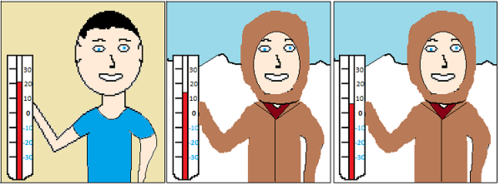Your Thermometer Can't Measure Below Freezing? Here's Another Approach!
 Andrew is very curious how cold it is outside, but he does not want to venture there for too long. Furthermore, his (home-made) thermometer is unable to measure below
0
∘
C
, and it's definitely way below freeing out there.
Andrew is very curious how cold it is outside, but he does not want to venture there for too long. Furthermore, his (home-made) thermometer is unable to measure below
0
∘
C
, and it's definitely way below freeing out there.
The thermometer currently shows a room temperature to 2 1 ∘ C . Andrew takes the thermometer outside and one minute later it shows 1 3 ∘ C . After another minute it shows 6 ∘ C . Fed up with the cold, Andrew heads back indoor for warmth. What is the outside temperature, in ∘ C ?
Note: Newton's Law of Cooling states that the rate of change of its temperature is proportional to the difference of its temperature and the temperature of its surroundings.
The answer is -43.
This section requires Javascript.
You are seeing this because something didn't load right. We suggest you, (a) try
refreshing the page, (b) enabling javascript if it is disabled on your browser and,
finally, (c)
loading the
non-javascript version of this page
. We're sorry about the hassle.
3 solutions
I dunno if what I did follows NLC but this is what I did:
I let x to be the temperature that is sought. The hint says that the change in temperature is proportional to the difference of the [current temperature reading in the thermometer] and the temperature of its surroundings. So,
1 3 − x 2 1 − 1 3 1 3 − x 8 ( 8 ) ( 6 − x ) 4 8 − 8 x − 4 3 = 6 − x 1 3 − 6 = 6 − x 7 = ( 7 ) ( 1 3 − x ) = 9 1 − 7 x = x
Erh, yeah, this could be more of algebra.
did the same way
Newton's Law of cooling states that: dT/dt is proportional to (To - Ta), where To = original temperature, Ta = ambient temperature, t = time dT/dt = -k (To - Ta) which can also be derived as T(t)= Ta + (To-Ta) e^{-kt)
We are given: To = 21, T(1) after 1 minute = 13 and T(2) after 2 minutes = 6
Therefore,
T(1) = 13 = Ta + (21-Ta) e^-k (13 - Ta)/(21-Ta) = e^-k
T(2) = 6 = Ta + (21-Ta) e^-k (6-Ta)/(21-Ta) = e^-2k
Solve for T using simultaneous equations - T=-43 and k=0.133531
I dont remember Newton's law of cooling except for the fact mentioned in the question. So the rate of cooling is proportional to the difference... so thats like a GP. Temperature lost in the 1st min = 8 Temperature lost in the 2nd min = 7 = 8 * (7/8) Temperature lost in the 3rd min = 8*(7/8)^2
If we take the infinity summation of this series, we will get the total temperature that would have been lost by the thermometer had it been outside for long time. At this stage, the temperature of the thermometer and surroundings will be same, so there will be negligible heat transfer.
therefore, total temperature lost = 8/(1-7/8) = 64 => outside temperateure = 21-64 = -43 :D
A c c o r d i n g t o N e w t o n ′ s L a w o f c o o l i n g : t Δ T ∝ ( T − T ′ ) w h e r e Δ T = c h a n g e i n t e m p e r a t u r e o f t h e b o d y t = t i m e t a k e n T = t e m p e r a t u r e o f t h e s u r r o u n d i n g T ′ = t e m p e r a t u r e o f b o d y a f t e r t i m e t 1 m i n 2 1 − 1 3 ∝ ( T − 1 3 ) 1 m i n 1 3 − 6 ∝ ( T − 6 ) ∴ 7 8 = T − 6 T − 1 3 S o l v i n g t h e a b o v e E q u a t i o n ⇒ T = − 4 3 0 C